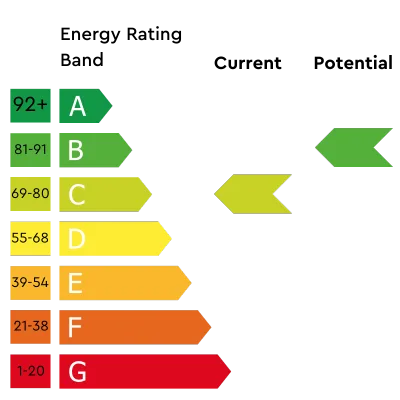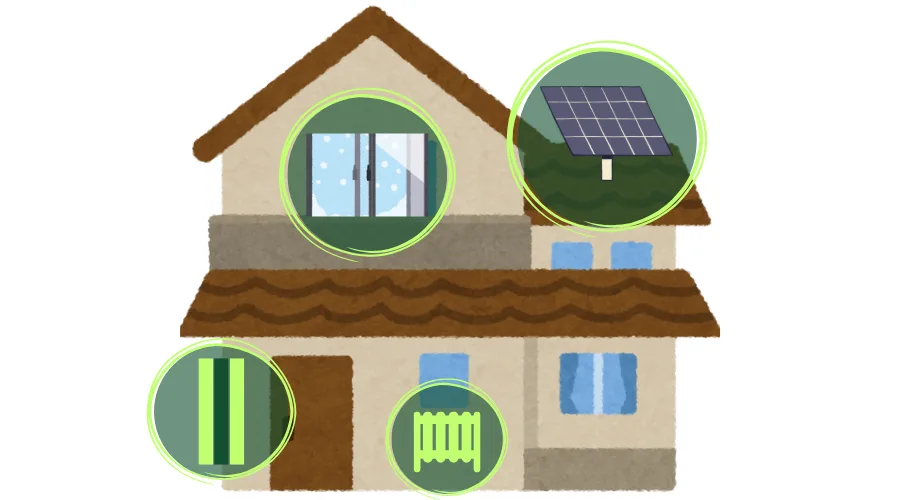
What Is An Energy Performance Certificate? (EPC)
An Energy Efficiency Certificate (EPC) or EPC Survey, measures a property’s energy efficiency, providing a rating from A (most efficient) to G (least efficient). This certificate is crucial because it indicates potential energy costs and environmental impacts. EPCs are legally required when selling or renting properties in the UK, ensuring that prospective buyers and tenants know the energy performance of a property before deciding. Properties with better EPC ratings often attract higher market values and more buyer interest.
In summary:
- Home Energy Performance
- Property Environmental Impact
- Recommendations and Advice On Relevant Home Energy Improvements
- Current Energy Usage
The ABCs of EPC Ratings:

- A (Most Efficient): Indicates energy-efficient properties with lower fuel bills and reduced carbon emissions.
- G (Least Efficient): Suggests high energy use, resulting in higher running costs and a larger carbon footprint
In addition to the current energy rating of the property being displayed, you will also receive a potential EPC rating. This potential EPC ratings is reflective of the potential performance of the property once all recommendations have been implemented.
Why Would You Need An EPC Survey?
- Selling a Property: If you’re selling a property, you need an EPC. It provides information about the property’s energy use, typical energy costs, and steps to improve energy efficiency. The EPC rates the property from A (best) to G (worst) and is valid for 10 years.
- Renting Out a Property: When renting out a property, you must also obtain an EPC. It helps potential tenants understand energy efficiency and costs.
- Building a New Property: For new constructions, an EPC is essential. It assesses energy efficiency and guides improvements.
Book Your EPC Survey With Cyd Innovation, Today
Remember, you must order an EPC before marketing your property for sale or rent. In Scotland, display the EPC within the property. If your property lacks an EPC or it has expired, arrange for a new one through an accredited assessor. Failing to obtain an EPC when required can result in fines. The seller, landlord, or letting agent must show you the EPC if you’re buying or renting. Exceptions include temporary buildings, small standalone structures, and certain other cases.
Where To Find Existing EPC Ratings
Properties in England, Wales or Northern Ireland: Click here
Properties in Scotland: Click here
The Finer Details Of EPCs
- Validity: EPC Surveys are valid for 10 years from the date of being issued.
- Inclusions: EPC Surveys will include official recommendations for improving home energy efficiency. Such may include insulations products, implemented by Retrofit Coordinators. Read more on how to spot a good retrofit coordination service, here. And ensure your home's energy efficiency is appropriately optimised.
How To Improve EPC Rating
The more energy efficient your home, essentially, the less it will cost on your upcoming energy bills. There is always the consciousness of contributing more positively to the environment by producing lower levels of CO2, making it great for your carbon footprint. Reading more on how to improve your EPC rating although requires time and money, is ultimately worth it. Whether you're a homeowner, or rent, you can still make some of the recommended energy efficient upgrades below which require minimal investment.

Lighting
Perhaps the less time and money expensive of the options includes switching your lightbulbs. Switching to energy efficient LED lights cost between £100-£200, saving up to £50 annually.
Heating Controls
Regulating your home temperature can range from simple thermostats and timers to more sophisticated wi-fi connected smart meters which learn your habits. Although they require investment, installing heating controls can result in significant energy cost savings. Some of the more popular options include the following:
- Digital Thermostats: A single sensor used to control the temperature of your whole house. Usually between £40-£120. Reducing your temperature even 1 degree can encourage savings on your energy bills.
- Programmable Timers: The freedom to set specific time intervals for when heating and hot water systems are available for use. The prices range from around £50-£70.
- Smart Thermostats: Wi-fi connected meters which allow control from your smartphone. Such offers features like remote access, smart scheduling etc. Many popular brands provide a range of smart thermostats, with prices ranging from £60-£200.
- Smart Radiator Controls: Similar to smart thermostats, these work with radiator valves to control individual room temperature. Starting from £50, can range up to £150.
Windows
Double glazing proves to be the more popular option to prevent heat loss through your windows. Options can vary significantly depending on material. Timber is the more expensive option, but lasts significantly longer than options such as UPVC, the more cost-effective and low-maintenance option. However, UPVC come in variations. Colour or woodgrain UPVC can cost up to 30% more than standard. Aluminium is more expensive than UPVC, but cheaper than timber. Installing such can save up to £140 a year.
Floor Insulation
Again, whilst floor insulation can require investment, quick fixes include sealing significant gaps between floors / floorboards to help draught proof. Sealant is the most popular option for this. Green Match provide a complete guide on floor insulation costs.
Wall Insulation
1/3 of all heating lost within a home is through walls. Whilst being one of the more expensive fixes, does also provide the greatest energy savings. The majority of homes within the UK have cavity walls, which means you can fill the gaps with relevant insulation measures. It is also important to note, there is a variety of wall insulation means providing various benefits and energy bill savings.
- Fiberglass Wall Insulation: Easy to install within open wall spaces and attics, fiberglass is the most commonly referred to solution for wall insulation. (Most affordable wall insulation at £7–£11 per m²)
- Cellulose: THE eco-friendly option made from recycled materials proves to be the environmentally responsible option (£10–£12 per m²)
- Spray Foam Wall Insulation: A liquid foam which expands and hardens into an airtight barrier to prevent air leakage. Because of its effectiveness, is the higher cost of all the options and also requires a "curing time" for which occupants are required to leave the property to allow for appropriate ventilation. (£21.50 per m² on average.)
- Reflective Wall Insulation: A thing, layered material which uses reflective foil to block heat transfer, also optimal for controlling moisture. (£20–£50 per m²)
- Mineral Wool Wall Insulation: A popular fire-efficient solution, provides high-density fibres for optimal thermal performance to improve your energy efficiency (£17–£20 per m² for internal wall use up to £140–£160 per m² for external wall applications )
Solar Panels
Solar panels cost from £6000 but provide average annual savings from £400-£1000. However, as expected, carry a significantly higher installation cost in comparison to the options above. The average cost is between £6000-£8000 with variables such as roof surface area and house size (bedrooms) playing a role within pricing. However, solar panels provide a great solution in cutting CO2 emissions. A standard solar systems can save 750kg+ of CO2 annually.
Please note, the above recommendations on how to improve your EPC are from qualified, professional Cyd Innovation energy assessors. Different house circumstances usually dictates the need for different EPC improvement measures to maximise energy saving capabilities. None of the above are 'Wrong' options, but tailored to different situations and in a lot of cases, houses.